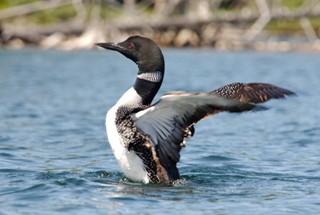Sep 11 2014
Biodiversity Research Institute’s (BRI’s) Adirondack Center for Loon Conservation and the Wildlife Conservation Society’s (WCS’s) Adirondack Program announced today that three new articles summarizing research on Adirondack loons have been published in a special issue of the journal Waterbirds that is dedicated to loon research and conservation in North America.
 A loon in the Adirondacks (Credit: Julie Larsen Maher)
A loon in the Adirondacks (Credit: Julie Larsen Maher)
“We are pleased to have our loon research in the Adirondack Park included in this unique publication,” stated Dr. Nina Schoch, Coordinator of BRI’s Adirondack Center for Loon Conservation. “The special issue includes fifteen scientific papers highlighting loon behavior, life history and population ecology, movements and migration, habitat and landscape requirements, and the risk contaminants pose to loon populations. The publication will be a valuable resource to help guide the conservation of loon populations throughout North America.”
The Common Loon (Gavia immer), one of five loon species worldwide, is a charismatic icon of New York’s Adirondack Park. These large, stunning black and white birds breed on Adirondack lakes, and serve as sentinels of the quality of the waterways where they summer. The Adirondack loon research was conducted by BRI and WCS in collaboration with the NYS Department of Environmental Conservation, SUNY ESF’s Adirondack Ecological Center, Paul Smiths Watershed Stewardship Program, and other partners.
The first study, titled “Wildlife Criterion Value for the Common Loon (Gavia immer) in the Adirondack Park, New York, USA,” estimated a water mercury threshold in Adirondack aquatic ecosystems that minimizes impacts from mercury pollution to loons breeding in the Park. The establishment of a Wildlife Criterion Value based on Adirondack loons provides legislators with a valuable new standard to incorporate into policies to better protect New York’s environmental quality. (link to study)
The second article, led by author Carolyn Spilman, is titled “The Effects of Lakeshore Development on Common Loon (Gavia immer) Productivity in the Adirondack Park, New York, USA.” This study concluded that it is important to place development (houses, boat houses etc.) in clusters along Adirondack lakeshores to buffer loon nest sites from disturbance related to developed areas. (link to study)
“We know that residential development has significant impacts on wildlife in the Adirondacks. This demonstrated impact to loons from development on the lakeshore reinforces the need for careful planning in this highly sensitive ecological zone. Using conservation development principles along lakeshores can help as much as in upland environments,” said Dr. Michale Glennon, Science Director for WCS’s Adirondack Program.
The third article is titled “The Impact of Mercury Exposure on the Common Loon (Gavia immer) Population in the Adirondack Park, New York, USA.” This study used Common Loons as a sentinel species to assess the risk and exposure of wildlife to environmental mercury pollution in New York’s Adirondack Park, and determined that 21% of male loons and 8% of females are at risk for behavioral and reproductive impacts based on elevated levels of mercury in their blood. Additionally, it was found that loons breeding on acidic lakes had higher mercury levels and produced fewer chicks than loons breeding on non-acidic lakes.
The studies were funded in part by the New York State Energy Research and Development Authority, John and Margot Ernst, the Edna Bailey Sussman Foundation, and the Betty Moore Chamberlain Fund, as well as numerous other donors.
The publication of the special issue of Waterbirds was supported by the Ricketts Conservation Foundation, which was formed to support the conservation of wildlife and natural resources. Underlying the Foundation's mission is the reality that government no longer has sufficient resources to deal effectively with the growing environmental challenges we face.